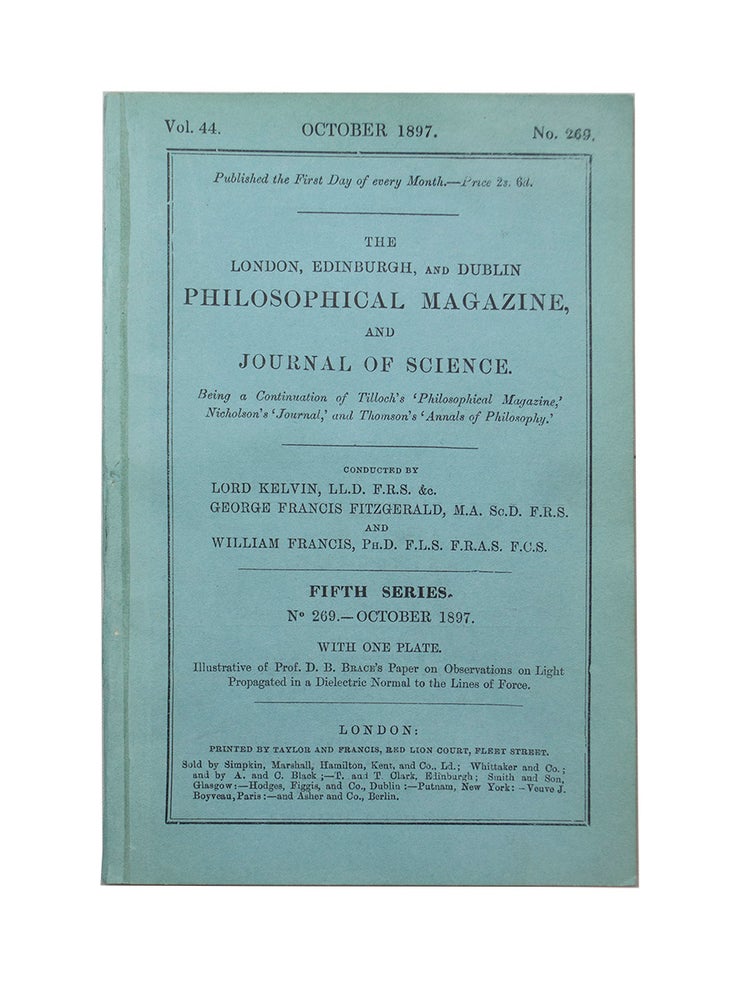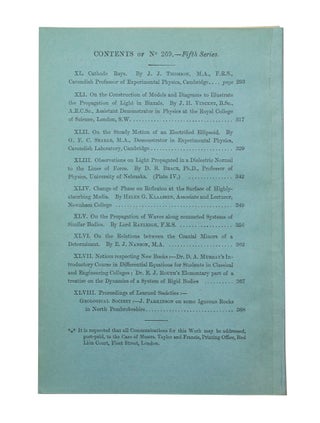Thomson's Discovery of the True Nature of Cathode Rays
Cathode Rays. in The London, Edinburgh, and Dublin Philosophical Magazine and Journal of Science. Fifth Series. No 269- October 1897.
London: Taylor and Francis, 1897.
Full Description:
THOMSON, Sir Joseph John. Cathode Rays. [In]: The London, Edinburgh, and Dublin Philosophical Magazine and Journal of Science. Being a Continuation of Tilloch's 'Philosophical Magazine,' Nicholson's 'Journal,' and Thomson's 'Annals of Philosophy.' Conducted by Lord Kelvin, LL.D. F.R.S. &c. George Francis Fitzgerald, M.A. Sc.D. F.R.S. and William Francis, Ph.D. F.L.S. F.R.A.S. F.C.S. 'Fifth Series.No 269- October 1897. With one plate. Illustrative of Prof. D.B. Brace's paper on Oberservations on Light Propagated in a Dielectric Normal to the lines of Force. London: Taylor and Francis, October, 1897.
First edition. Octavo (8 7/16 x 5 9/16 inches; 215 x 142 mm). 293-368 pp. Thomson's article on Cathode rays comprised pages 293-316 with six black and white line-drawings, some numerical charts and equations. Along this article are eight other articles and one engraved plate.
Publisher's original blue printed wrappers, neatly rebacked to style. Edges speckled red. We could find no other copy in the original wrappers at auction. An about fine copy.
This was the first of Thomson's papers on the discovery of sub-atomic particles.
"It was reserved for J.J. Thomson (knighted in 1908) to discover the true nature of the cathode rays. In April 1897 he gave a public demonstration at one of the Friday evening discourses at the Royal Institute in which he declared that cathode rays are composed of particles of sub-atomic proportions. At this stage, he had been unable to calculate the weight of the particles, but he had measured their rate of charge to mass. The ratio was large, so they must either have a big charge or a small mass. Thomson gave reasons for preferring the latter-from experiments performed by Kenard in particular.
If the charge could be calculated, then the mass could be found, since the ratio between the two was known, Thomson eventually succeeded in calculating the charge, by an ingenious adaptation of the 'dust counter' devised by C.T.R. Wilson. Thomson substituted for the dust particles counted by Wilson the cathode-ray particles. By observing variations in their fall in various electric fields he was able to calculate the electric charge of the particles. These experiments, later perfected by Millikan, led to the calculation of the mass of the electron as one eighteen-hundredth of a hydrogen atom, hitherto the lightest known object. Moreover the mass of these 'corpuscles', as Thomson called them, was constant, whatever their origin. That is to say that all forms of matter, no matter how varied their chemical composition, produced cathode rays of uniform make-up... Although he still preferred as late as 1907 'corpuscle' to 'electron' to describe this ultimate particle, Thomson has provided experimental proof of the theoretical speculation of Lorentz. In doing so he had revolutionized the science of physics. The 'indestructible' atom was no more and it began to seem likely that the common constituent of all matter was a form of energy. Thomson's discovery opened up new fields of investigation in almost every branch of physics..." (PMM 386).
Printing and the Mind of Man 386.
HBS 68815.
$4,500.
Price: $4,500.00
Item #68815




